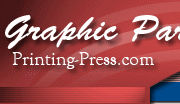History of the Printing Press
The Early Printing Press
Arguably the most influential and important invention in the history of Western civilization, the printing press began and continues to revolutionize the way information is absorbed and transmitted through a population. The ability of Europe to rise above its status as a second-tier civilization can be attributed to the printing press; communication as we know it is based on it.
Often credited as single-handedly conceiving of the printing press, Johann Gutenberg simply had a new innovation on an existing system. Block printing was a means of mass production of pages that was known throughout the Middle Ages in Europe and elsewhere. It used a single piece of wood or clay that was carved with the letters and words of a single page. While some editions of the Bible were printed using this technique, it was largely impractical. Blocks might break and render a number of pages in a voluminous tome unreadable, and it was deemed less valuable artistically than hand written works.
In the Middle and Far East, block printing was used routinely for pamphlets and other small written works. However, both had an emphasis on calligraphy and the beauty of words themselves. It is believed that as early as the mid-eleventh century in China and the mid-thirteenth century in the Ottoman Empire that moveable type was perfected. In the Chinese empire, the numerous characters and minute detail of word characters made this development no more advantageous than handwriting. In the Middle East, creating moveable type based on Arabic proved difficult and allegedly decreased readability.
There are equal amounts of evidence to conclude that Johann Gutenberg either developed moveable type on his own or from a chain of sources that stretch back to East Asia and the Middle East. In any event, his invention allowed any page to be produced from a uniform set of blocks quickly. The rest is history: literacy increases, higher standards of learning evolve, and the ability to transmit coherent messages made long distance communication possible. One of the most convincing theories as to why printing presses became a viable economic investment and why their technology developed so rapidly has much to do with the Bible. In Christian countries it is the one book that is guaranteed to always have a market (more so and especially in the fifteenth century). The Middle East and Asia lacked such a work. Many of their sacred books were considered more valuable and holy because they were handwritten. Those cultures also value oral passage and discussion, which Europe quickly shunned in favor of private reading and reflection.
New Developments in Printing
For over three hundred years, the printing press remained relatively unchanged. It was so effective that, aside from superficial changes, the inner workings of a Gutenberg printing press might be indistinguishable from those of an early nineteenth century press. Steam power was applied in 1812, but it simply reduced the amount of human energy that went into the process of printing. It would not be until the development of lithography that printing underwent a fundamental change.
Named for the Ancient Greek word for stone (the process was originally done on limestone), lithography could be said to custom create one giant printing block. In use, an oil-based image is drawn onto a metal plate. Acid is then burned onto the image, avoiding the oily surfaces and eating into the remaining areas. A waxy substance, gum arabic was then applied and attached to the non-oily surfaces. When applied to the plate, ink would adhere to the oily parts while water was attracted to the parts covered in gum arabic.
This process was a leap forward in printing. Not only could images be represented and combined with words, but much greater detail could be put forth. Maps, diagrams and models no longer had to be hand-drawn. Chromolithography was soon developed. It laid down a different color ink in each subsequent rolling. The only difficulty was in standardizing the position of paper so that each rolling lined up perfectly with the last.
Modern Lithography
Lithography today uses aluminum or plastic instead of limestone or iron. Rather than using an acidic bath and oil-based covering, modern plates are covered with a photosensitive substance. A photographic negative is then placed on the plate and exposed to light. A positive image is now transferred to the plate. The unexposed portions of the photosensitive substance are removed with a chemical mix, and the plate is then inserted into a printing press. Water is applied to the plate, which adheres to the negative areas of the image. It is then inked.
If the plate was then put to paper, it would transfer the image but would also wet the document. Instead, a rubber roller is rolled over the plate to squeeze away water and absorb the ink. The roller is then run over the paper and transfers the image. This step including the rubber is referred to as “offset lithography.”
In the recent past, it was necessary to draft an image or lines of text and apply them to the plate in the fashion mentioned above. In the early days of computers it was possible to print a layout and then apply it to the plates, negating much of the human element of printing. However, in the last decade or so desktop publishing has given printers the ability to go right from the computer to the printing press. Platesetting refers to a process that configures the lithographic plate instantly with information from a computer.
How can I find out more information?
We would be happy to provide you with a prompt and professional quotation on a printing press thats right for you. When you request a printing press quote you will receive a courteous and professional response with options you can choose. Take me There
| Home | Learning Center | Links | About Us | Contact Us | Join Our Network
|
